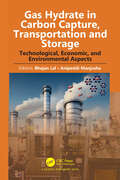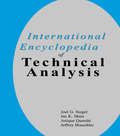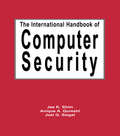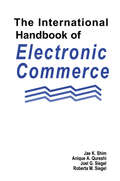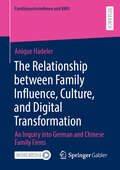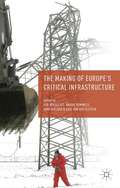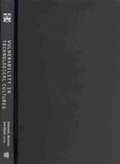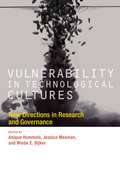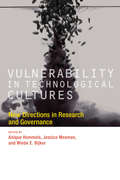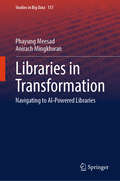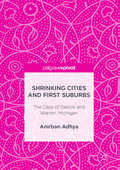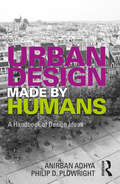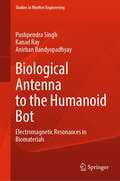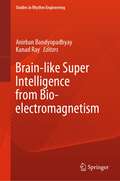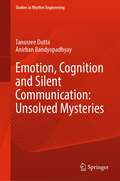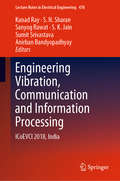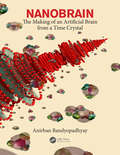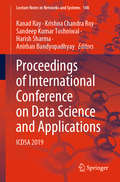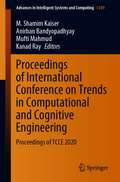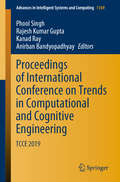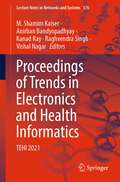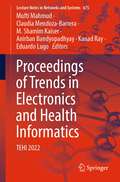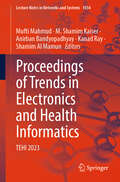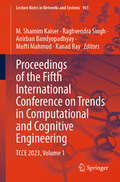- Table View
- List View
Gas Hydrate in Carbon Capture, Transportation and Storage: Technological, Economic, and Environmental Aspects
by Bhajan Lal Anipeddi ManjushaThis book offers a deep insight into gas hydrate-based carbon capture, transportation, and storage technology as a solution to decarbonization. The key aspects of carbon capture & storage technologies are discussed together with their advantages and status of development and commercialization. The authors delve into intricacies of gas hydrate reactor design, provide a review on the Techno-Economic Aspects (TEA), expound critical safety considerations and elucidate upon the regulatory mandates shaping the landscape of decarbonization initiatives.Gas Hydrate in Carbon Capture, Transportation and Storage: Technological, Economic, and Environmental Aspects is an essential resource for all academicians, researchers, flow assurance engineers, industry professionals and students working in this field.
International Encyclopedia of Technical Analysis
by Jae K. Shim Joel G. Siegel Anique A. Qureshi Jeffrey BrauchlerInvestors are firmly entrenched in two camps: those who believe that economic and financial fundamentals are the keys to investment success, and those who prefer some form or other of technical analysis. To serve those who use technical analysis, the authors have written a practical, useful, and comprehensive guide to all the major and minor technical analysis systems used by today's investors and financial professionals. In this unique reference book, technical analysis systems are discussed in depth, with detailed attention to the pros and cons of each. In addition, the Encyclopedia offers a mini-dictionary of the terms, concepts, and market issues that are part of the discipline of technical analysis.
The International Handbook of Computer Security
by Joel G. Siegel Anique A. Qureshi Jae ShimThe International Handbook of Computer Security is designed to help information systems/computer professionals as well as business executives protect computer systems and data from a myriad of internal and external threats. The book addresses a wide range of computer security issues. It is intended to provide practical and thorough guidance in what often seems a quagmire of computers, technology, networks, and software. Major topics discussed are: security policies; physical security procedures; data preservation and protection; hardware and software protection and security; personnel management and security; network security, internal and external systems; contingency planning; legal and auditing planning and control.
The International Handbook of Electronic Commerce
by Jae K. Shim Joel G. Siegel Anique A. Qureshi Roberta M. SiegelThe International Handbook of Electronic Commerce covers that hot topic - e-commerce! It is designed to assist managers in implementing electronic commerce in their organizations, improving its efficiency and viability, and safeguarding and maintaining e-commerce systems. The book is designed as a practical how to guide, offering extensive examples to illustrate practical applications. The tools and techniques in this handbook can be adapted outright or modified to suit individual needs. Checklists, email and website addresses, exhibits, illustrations, and step-by-step instructions enhance the handbook's practical use. Among the topics discussed are: what electronic commerce is all about; the Internet and access provider industry; Intranets and Extranets; marketing and advertising; electronic data interchange; electronic banking and payment systems; network security; legal, taxation, and accounting issues of e-commerce. The combination of growth in the commercial utilization of the Internet, the rapid changes in technology, and the complexity of management have expanded the scope of duties of business managers. To remain competitive, businesses and their managers must maintain a presence on the Internet. The International Handbook of Electronic Commerce provides readers with a compendium of the latest in current technologies and applications.
The Relationship between Family Influence, Culture, and Digital Transformation: An Inquiry into German and Chinese Family Firms (Familienunternehmen und KMU)
by Anique HadelerIn an era marked by the rapid development of digital technologies, established firms face the necessity of digital transformation to remain competitive with digitally native entrants. Despite the acknowledged economic importance of digital transformation for family firms, the evidence is split. While some research suggests that family firms may grapple with digital transformation due to their traditional roots and rigid structures, many family firms are at the forefront of digital transformation within their industries. These differences suggest that there may be family-specific and contextual factors at play that shape the scope and pace at which family firms engage in digital transformation. This book addresses this ambiguity by adopting a qualitative, exploratory approach, employing grounded theory methodology to disentangle the interplay of family influence and national culture with digital transformation in family firms. Drawing on rich qualitative data from 31 semi-structured interviews with German and Chinese family firms and 24 expert interviews with digital transformation professionals, a process model emerged to deepen our understanding of family and cultural influences in shaping the digital transformation process. Cultural differences between German and Chinese family firms influence the way digital transformation unfolds but, contrary to initial expectations, play a minor role in explaining differences in the pace of digital transformation. Family influence appeared to be a more salient explanation for these differences. The findings show that family influence has a yin and yang effect in that it can bring friction and uncertainty but also promote alignment and long-term resilience. Ultimately, the family’s stance on digital transformation shapes both its initiation and execution. In addition, this book sheds light on the decision logic underlying the uncertain and emerging conditions of digital transformation and offers practitioners valuable insights into the likely impact of these decisions on future outcomes.
The Making of Europe�s Critical Infrastructure
by Anique Hommels Per H�gselius Arne Kaijser Erik van der VleutenEurope's critical infrastructure is a key concern to policymakers, NGOs, companies, and citizens today. A 2006 power line failure in northern Germany closed lights in Portugal in a matter of seconds. Several Russian-Ukrainian gas crises shocked politicians, entrepreneurs, and citizens thousands of kilometers away in Germany, France, and Italy. This book argues that present-day infrastructure vulnerabilities resulted from choices of infrastructure builders in the past. It inquires which, and whose, vulnerabilities they perceived, negotiated, prioritized, and inscribed in Europe's critical infrastructure. It does not take 'Europe' for granted, but actively investigates which countries and peoples were historically connected in joint interdependency, and why. In short, this collection unravels the simultaneous historical shaping of infrastructure, common vulnerabilities, and Europe.
Vulnerability in Technological Cultures
by Wiebe E. Bijker Jessica Mesman Anique HommelsNovel technologies and scientific advancements offer not only opportunities but risks. Technological systems are vulnerable to human error and technical malfunctioning that have far-reaching consequences: one flipped switch can cause a cascading power failure across a networked electric grid. Yet, once addressed, vulnerability accompanied by coping mechanisms may yield a more flexible and resilient society. This book investigates vulnerability, in both its negative and positive aspects, in technological cultures. The contributors argue that viewing risk in terms of vulnerability offers a novel approach to understanding the risks and benefits of science and technology. Such an approach broadens conventional risk analysis by connecting to issues of justice, solidarity, and livelihood, and enabling comparisons between the global north and south. The book explores case studies that range from agricultural practices in India to neonatal intensive care medicine in Western hospitals; these cases, spanning the issues addressed in the book, illustrate what vulnerability is and does. The book offers conceptual frameworks for empirical description and analysis of vulnerability that elucidate its ambiguity, context dependence, and constructed nature. Finally, the book addresses the implications of these analyses for the governance of vulnerability, proposing a more reflexive way of dealing with vulnerability in technological cultures.ContributorsMarjolein van Asselt, Martin Boeckhout, Wiebe Bijker, Tessa Fox, Stephen Healy, Anique Hommels, Sheila Jasanoff,Jozef Keulartz, Jessica Mesman, Ger Palmboom, C. Shambu Prasad, Julia Quartz, Johan M. Sanne, Maartje Schermer, Teesta Setelvad, Esha Shah, Andy Stirling, Imrat Verhoeven, Esther Versluis, Shiv Visvanathan, Gerard de Vries, Ger Wackers, Dick Willems
Vulnerability in Technological Cultures
by Wiebe E. Bijker Jessica Mesman Anique HommelsNovel technologies and scientific advancements offer not only opportunities but risks. Technological systems are vulnerable to human error and technical malfunctioning that have far-reaching consequences: one flipped switch can cause a cascading power failure across a networked electric grid. Yet, once addressed, vulnerability accompanied by coping mechanisms may yield a more flexible and resilient society. This book investigates vulnerability, in both its negative and positive aspects, in technological cultures. The contributors argue that viewing risk in terms of vulnerability offers a novel approach to understanding the risks and benefits of science and technology. Such an approach broadens conventional risk analysis by connecting to issues of justice, solidarity, and livelihood, and enabling comparisons between the global north and south. The book explores case studies that range from agricultural practices in India to neonatal intensive care medicine in Western hospitals; these cases, spanning the issues addressed in the book, illustrate what vulnerability is and does. The book offers conceptual frameworks for empirical description and analysis of vulnerability that elucidate its ambiguity, context dependence, and constructed nature. Finally, the book addresses the implications of these analyses for the governance of vulnerability, proposing a more reflexive way of dealing with vulnerability in technological cultures.ContributorsMarjolein van Asselt, Martin Boeckhout, Wiebe Bijker, Tessa Fox, Stephen Healy, Anique Hommels, Sheila Jasanoff,Jozef Keulartz, Jessica Mesman, Ger Palmboom, C. Shambu Prasad, Julia Quartz, Johan M. Sanne, Maartje Schermer, Teesta Setelvad, Esha Shah, Andy Stirling, Imrat Verhoeven, Esther Versluis, Shiv Visvanathan, Gerard de Vries, Ger Wackers, Dick Willems
Vulnerability in Technological Cultures: New Directions in Research and Governance (Inside Technology)
by Wiebe E. Bijker Jessica Mesman Anique HommelsAnalysis and case studies explore the concept of vulnerability, offering a novel and broader approach to understanding the risks and benefits of science and technology.Novel technologies and scientific advancements offer not only opportunities but risks. Technological systems are vulnerable to human error and technical malfunctioning that have far-reaching consequences: one flipped switch can cause a cascading power failure across a networked electric grid. Yet, once addressed, vulnerability accompanied by coping mechanisms may yield a more flexible and resilient society. This book investigates vulnerability, in both its negative and positive aspects, in technological cultures. The contributors argue that viewing risk in terms of vulnerability offers a novel approach to understanding the risks and benefits of science and technology. Such an approach broadens conventional risk analysis by connecting to issues of justice, solidarity, and livelihood, and enabling comparisons between the global north and south.The book explores case studies that range from agricultural practices in India to neonatal intensive care medicine in Western hospitals; these cases, spanning the issues addressed in the book, illustrate what vulnerability is and does. The book offers conceptual frameworks for empirical description and analysis of vulnerability that elucidate its ambiguity, context dependence, and constructed nature. Finally, the book addresses the implications of these analyses for the governance of vulnerability, proposing a more reflexive way of dealing with vulnerability in technological cultures.ContributorsMarjolein van Asselt, Martin Boeckhout, Wiebe Bijker, Tessa Fox, Stephen Healy, Anique Hommels, Sheila Jasanoff, Jozef Keulartz, Jessica Mesman, Ger Palmboom, C. Shambu Prasad, Julia Quartz, Johan M. Sanne, Maartje Schermer, Teesta Setelvad, Esha Shah, Andy Stirling, Imrat Verhoeven, Esther Versluis, Shiv Visvanathan, Gerard de Vries, Ger Wackers, Dick Willems
Libraries in Transformation: Navigating to AI-Powered Libraries (Studies in Big Data #157)
by Phayung Meesad Anirach MingkhwanThis book discovers how libraries evolved in the digital age with “Libraries in Transformation: Navigating to AI-powered Libraries.” This insightful book explores the profound shifts within libraries due to the integration of advanced technologies such as artificial intelligence (AI) and the Internet of Things (IoT). Providing a comprehensive roadmap, this book guides libraries in adapting and thriving while maintaining their core mission of providing universal access to knowledge and fostering community engagement.
Markets, Capitalism and Urban Space in India: Right to Sell (Routledge Research on Urban Asia)
by Anirban AcharyaThis book analyses the question of the right to the city, informal economies and the non-western shape of neoliberal governance in India through a new analytic: the right to sell. The book examines why and how states attempt to curb, control, and eliminate markets of urban informal street vendors. Focusing on Kolkata, the author provides a theoretical explanation of this puzzle by distilling and analysing the inherent tensions among the constitutive elements of neoliberal governance, namely, growth imperative, market activism, and corporatization, and demonstrates its implications for the formal/informal boundaries of the economy. A useful addition to the existing literatures on the right to the city, informal economies, and the shapes that neoliberalism takes in the non-west, the book provides a non-western counter to accounts of neoliberalism and will be of interest to academics working in the fields of South Asian Studies, Urban Studies, and Political Economy.
Shrinking Cities and First Suburbs
by Anirban AdhyaThis book examines Warren, a suburb of Detroit, Michigan, as a shrinking city facing a crisis of economic downturn, automotive restructuring, high unemployment, and real estate foreclosures. The author explores Warren's attempt to develop planning strategies, culturally-based initiatives, community design projects, and creative partnerships in the region in order to address the challenges of shrinkage and foreclosures at multiple scales. Global urban development is currently characterized by varied combination of metropolitan growth and urban core shrinkage. While much of the shrinkage is concentrated in central cities, first suburbs are now facing the same problem. The Warren case illustrates opportunities for flexible policies combining rightsizing, shared maintenance, and incremental development in struggling first suburban communities, which are less studied and often ignored.
Urban Design Made by Humans: A Handbook of Design Ideas
by Anirban Adhya Philip D. PlowrightThe design of urban environments is complex and involves diverse needs, organisations, professions, authorities, and communities. It requires relationships to be constructed and sustained between infrastructure, resources, and populations across multiple scales. This can be quite daunting. However, at the core of urban design is a simple idea—our urban spaces are designed to allow people and communities to thrive. For that reason, a good starting point for urban designers is to focus on the way people think when engaging our built environment. This thinking is embodied, developed through the interactions between our mind, body, and the environment around us. These embodied concepts are central to how we see the world, how we move and gather, and how we interact with others. They are also the same ideas we use to design our environments and cities. Urban Design Made by Humans is a reference book that presents 56 concepts, notions, ideas, and agreements fundamental to the design and interpretation of our human settlements. The ideas here parallel those found in Making Architecture Through Being Human but extends them into urban environments. Urban Design Made by Humans distinctly highlights priorities in urban design in how we produce meaningful environments catering to wider groups of people. Each idea is isolated for clarity with short and concise definitions, examples, and illustrations. They are organised in five sections of increasing complexity. Taken as a whole, the entries frame the priorities and values of urban design while also being instances of a larger system of human thinking.
Biological Antenna to the Humanoid Bot: Electromagnetic Resonances in Biomaterials (Studies in Rhythm Engineering)
by Kanad Ray Anirban Bandyopadhyay Pushpendra SinghThe book outlines a pathway to the development of fusion of electromagnetic resonance and artificial intelligence which will dominate the world of communication engineering. Electromagnetic resonance is fundamental to all biomaterials. The authors explore the peculiarities of this typical resonance behaviour in the literatures and provide the key points where the research should direct. Biological antennas are inspiring designing of several electromagnetic devices. From biomimetic engineering to humanoid bots a revolution is undergoing. Authors include entire development in the form of a book along with their contribution to this field.
Brain-like Super Intelligence from Bio-electromagnetism (Studies in Rhythm Engineering)
by Kanad Ray Anirban BandyopadhyayThis book discusses various aspects of bioinspired technologies but with an additional emphasis on the medical science, starting from the popular article on neurobiology to pure biophysics that ends with the superintelligence of biological systems that could be reverse engineered. It covers eight different aspects of natural intelligence, starting from the fundamental electromagnetic properties of a protein to the vibrations and the resonance of the entire biomaterial system. It also covers a wide spectrum of hierarchical communication among different biological systems for intelligence and then medical science is applied.
Emotion, Cognition and Silent Communication: Unsolved Mysteries (Studies in Rhythm Engineering)
by Anirban Bandyopadhyay Tanusree DuttaThis book provides an answer to the readers about scientific perspective on learning. It presents a culminating point of four different kinds of studies designed to measure and understand the nuances of brain functioning. The objective of this book is to find answers to four questions: (1) can there be a neuroscientific understanding of the concept of individual differences? (2) does rhythmic sound or noise have an impact on decision making? (3) how does transfer of learning between the hemispheres facilitate the learning process? and lastly (4) beyond the accepted ways of communicating verbally and non-verbally is silent communication possible? This book makes an attempt to address these issues through various aspects of inner-conscious engineering.
Engineering Vibration, Communication and Information Processing: Icoevci 2018, India (Lecture Notes In Electrical Engineering #478)
by S. K. Jain Kanad Ray Sanyog Rawat Anirban Bandyopadhyay Sumit Srivastava S. N. SharanThis book discusses the revolution of cycles and rhythms that is expected to take place in different branches of science and engineering in the 21st century, with a focus on communication and information processing. It presents high-quality papers in vibration sciences, rhythms and oscillations, neurosciences, mathematical sciences, and communication. It includes major topics in engineering and structural mechanics, computer sciences, biophysics and biomathematics, as well as other related fields. Offering valuable insights, it also inspires researchers to work in these fields. The papers included in this book were presented at the 1st International Conference on Engineering Vibration, Communication and Information Processing (ICoEVCI-2018), India.
Nanobrain: The Making of an Artificial Brain from a Time Crystal
by Anirban BandyopadhyayMaking an artificial brain is not a part of artificial intelligence. It will be a revolutionary journey of mankind exploring a science where one cannot write an equation, a material will vibrate like geometric shape, and then those shapes will change to make decisions. Geometry of silence plays like a musical instrument to mimic a human brain; our thoughts, imagination, everything would be a 3D shape playing as music; composing music would be the brain’s singular job. For a century, the Turing machine ruled human civilization; it was believed that irrespective of complexity all events add up linearly. This book is a thesis to explore the science of decision-making where events are 3D-geometric shapes, events grow within and above, never side by side. The book documents inventions and discoveries in neuroscience, computer science, materials science, mathematics and chemistry that explore the possibility of brain or universe as a time crystal. The philosophy of Turing, the philosophy of membrane-based neuroscience and the philosophy of linear, sequential thought process are challenged here by considering that a nested time crystal encompasses the entire conscious universe. Instead of an algorithm, the pattern of maximum free will is generated mathematically and that very pattern is encoded in materials such that its natural vibration integrates random events exactly similar to the way nature does it in every remote corner of our universe. Find how an artificial brain avoids any necessity for algorithm or programming using the pattern of free will.
Proceedings of International Conference on Data Science and Applications: ICDSA 2019 (Lecture Notes in Networks and Systems #148)
by Kanad Ray Anirban Bandyopadhyay Harish Sharma Krishna Chandra Roy Sandeep Kumar ToshniwalThis book gathers outstanding papers presented at the International Conference on Data Science and Applications (ICDSA 2019), held at Kautilya Institute of Technology and Engineering, Jaipur, Rajasthan, India, from 2 to 3 December 2019. It covers theoretical and empirical developments in various areas of big data analytics, big data technologies, decision tree learning, wireless communication, wireless sensor networking, bioinformatics and systems, artificial neural networks, deep learning, genetic algorithms, data mining, fuzzy logic, optimization algorithms, image processing, computational intelligence in civil engineering, creative computing, etc.
Proceedings of International Conference on Trends in Computational and Cognitive Engineering: Proceedings of TCCE 2020 (Advances in Intelligent Systems and Computing #1309)
by Kanad Ray Anirban Bandyopadhyay Mufti Mahmud M. Shamim KaiserThis book presents various computational and cognitive modeling approaches in the areas of health, education, finance, environment, engineering, commerce, and industry. It is a collection of selected conference papers presented at the International Conference on Trends in Computational and Cognitive Engineering (TCCE 2020). It shares cutting-edge insights and ideas from mathematicians, engineers, scientists, and researchers and discusses fresh perspectives on problem solving in a range of research areas.
Proceedings of International Conference on Trends in Computational and Cognitive Engineering: TCCE 2019 (Advances in Intelligent Systems and Computing #1169)
by Kanad Ray Anirban Bandyopadhyay Phool Singh Rajesh Kumar GuptaThis book presents various computational and cognitive modeling approaches in the areas of health, education, finance, theenvironment, engineering, commerce and industry. Gathering selected conference papers presented atthe International Conference on Trends in Computational and Cognitive Engineering (TCCE), it sharescutting-edge insights and ideas from mathematicians, engineers, scientists and researchers anddiscusses fresh perspectives on problem solving in a range of research areas.
Proceedings of Trends in Electronics and Health Informatics: TEHI 2021 (Lecture Notes in Networks and Systems #376)
by Kanad Ray Anirban Bandyopadhyay M. Shamim Kaiser Raghvendra Singh Vishal NagarThis book includes selected peer-reviewed papers presented at the International Conference on Trends in Electronics and Health Informatics (TEHI 2021), organized by Department of Electronics and Communication Engineering and Department of Computer Science and Engineering, Pranveer Singh Institute of Technology Kanpur, India, during 16–17 December 2021. The book is broadly divided into five sections—artificial intelligence and soft computing, healthcare informatics, Internet of things and data analytics, electronics, and communications.
Proceedings of Trends in Electronics and Health Informatics: TEHI 2022 (Lecture Notes in Networks and Systems #675)
by Kanad Ray Anirban Bandyopadhyay Mufti Mahmud M. Shamim Kaiser Claudia Mendoza-Barrera Eduardo LugoThis book includes selected peer-reviewed papers presented at the International Conference on Trends in Electronics and Health Informatics (TEHI 2022), held at University of Puebla, Puebla, México, during December 7–9, 2022. The book is broadly divided into five sections—artificial intelligence and soft computing, healthcare informatics, Internet of things and data analytics, electronics, and communications.
Proceedings of Trends in Electronics and Health Informatics: TEHI 2023 (Lecture Notes in Networks and Systems #1034)
by Kanad Ray Anirban Bandyopadhyay Mufti Mahmud M. Shamim Kaiser Shamim Al MamunThis book includes selected peer-reviewed papers presented at the International Conference on Trends in Electronics and Health Informatics (TEHI 2023), held at Institute of Information Technology, Jahangirnagar University, Dhaka, Bangladesh, during December 26–27, 2023. The book is broadly divided into five sections—artificial intelligence and soft computing, healthcare informatics, Internet of things and data analytics, electronics, and communications.
Proceedings of the Fifth International Conference on Trends in Computational and Cognitive Engineering: TCCE 2023, Volume 1 (Lecture Notes in Networks and Systems #961)
by Kanad Ray Anirban Bandyopadhyay Mufti Mahmud M. Shamim Kaiser Raghvendra SinghThis book presents various computational and cognitive modeling approaches in the areas of health, education, finance, environment, engineering, commerce and industry. It is a collection of selected conference papers presented at the 5th International Conference on Trends in Cognitive Computation Engineering (TCCE 2023), organized by Pranveer Singh Institute of Technology, Kanpur Uttar Pradesh, India in collaboration with IIOIR, Shimla, Himachal Pradesh, India, during 24 – 25 November 2023. The book is divided into two volumes, and it shares cutting-edge insights and ideas from mathematicians, engineers, scientists, and researchers and discusses fresh perspectives on problem solving in a range of research areas.
